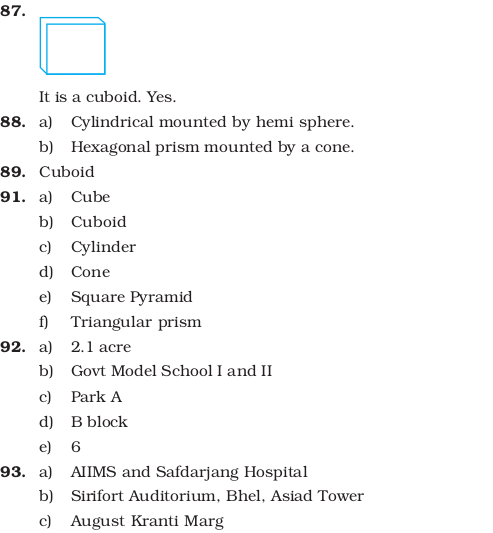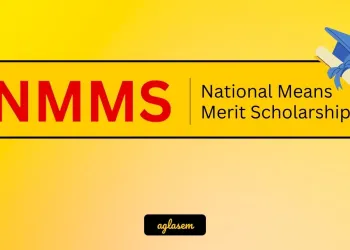Candidates can download NCERT Exemplar Class 8 Maths Unit 6 from this page. The exemplar has been provided by the National Council of Educational Research & Training (NCERT) and the candidates can check it from below for free of cost. It contains objective, very short answer type, short answer type, and long answer type questions. Along with it, the answer for each question has also been provided. From the NCERT Exemplar Class 8 Maths Unit 6, candidates can understand the level and type of questions that are asked in the exam.
NCERT Exemplar Class 8 Maths Unit 6 Visualising Solid Shapes
NCERT Class 8 Maths Unit 6 is for Visualising Solid Shapes. The type of questions that will be asked from NCERT Class 8 Maths Unit 6 are displayed in the below provided NCERT Exemplar Class 8 Maths Unit 6. With the help of it, candidates can prepare well for the examination.
Also Check: NCERT Solutions for Class 8 Maths
- 3D shapes/objects are those which do not lie completely in a plane.
- 3D objects have different views from different positions.
- A solid is a polyhedron if it is made up of only polygonal faces, the faces meet at edges which are line segments and the edges meet at a point called vertex.
- Euler’s formula for any polyhedron is, F + V – E = 2. Where F stands for number of faces, V for number of vertices and E for number of edges.
- Types of polyhedrons:

(1) and (2) are convex polyhedrons whereas
(3) and (4) are non convex polyhedron.
- Regular polyhedra or platonic solids: A polyhedron is regular if its faces are congruent regular polygons and the same number of faces meet at each vertex. For example, a cube is a platonic solid because all six of its faces are congruent squares. There are five such solids– tetrahedron, cube, octahedron, dodecahedron and icosahedron. e.g.

- A prism is a polyhedron whose bottom and top faces (known as bases) are congruent polygons and faces known as lateral faces are parallelograms (when the side faces are rectangles, the shape is known as right prism).
- A pyramid is a polyhedron whose base is a polygon and lateral faces are triangles.
- A map depicts the location of a particular object/place in relation to other objects/places.
Try This

- Scale is the relationship between the drawing’s/model’s dimensions to the actual object’s dimensions.
- In a map, symbols are used to depict the different objects and places
- Maps involve a scale which is fixed for a particular map.
Think and Discuss
- Explain how you would find the surface area of an open-top box that is shaped like a rectangular prism.
- Describe the shapes in a net used to cover a cylinder.
Solved Examples
In examples 1 and 2, write the correct answer from the given four options.

In examples 3 and 4, fill in the blanks to make the statements true



Activity


Try This








Think and Discuss







Multiple Choice Questions

Fill in the Blanks Type Questions

True False Type Questions

Short Answer Type Questions

Activities
Activity 1: Find the most appropriate way to reach from start to finish. (Use a coloured pen of your choice to show the path traced.)


Activity 2: Rohit is a 7 year old young boy. His uncle Raj asked him to draw a map to reach Sport’s Complex from his (Rohit’s) house. He drew the following map.

Activity 3: Look at the map of city given on the next page:
(a) Colour the map using the given colour code as follows. Blue-water, Red-Fire station, White-Hospital, GreenParks, Cream-River Bed, Brown-Mountains.
(b) Mark the shortest route from House to Pool with the help of arrowes.
(c) Put X at the intersection of Chatra Marg and House Lane.

Activity 4: Draw the nets given below on coloured sheets by taking each side of the triangle as 3cm, and try to form the shapes shown in front of it. Count the number of edges, faces and vertices in ends and verify the Euler’s formula.


Activity 5: Guess who am I? My name is given in the box below. Oops! Spelling of my name is jumbled up. Try to identify it from the clues given below and write it in the blank space.
(1) I am a polyhedron with least number of faces. ________
(2) I am a prism whose all faces are square. ________
(3) Looks like marbles but have no vertex. ________
(4) I am a solid whose base is polygonal and other faces are triangles. ________

Activity 6: Draw the map of your locality, showing the details of your sector/ block. Also highlight the appropriate landmarks which will help your friend to locate your house in your sector/block.
Activity 7: Crossword Puzzle
Answer the following based on the hints given below.
Across
1. Polyhedron whose lateral faces are parallelograms.
2. Prism having fifteen edges.
5. Another name for a square prism.
7. Polyhedron made up of four triangles.
9. Polyhedron made up of convex polygons.
Down
2. Polyhedron whose lateral faces are triangles.
3. In a solid shape, the line segment joining two vertices not lying on the same face.
4. A 3-D shape having no vertex.
6. A solid figure having only one vertex.
7. Number of pentagons in a pentagonal prism.
10. Point where edges of a solid shape meet.

Click here to downlod the NCERT Exemplar Class 8 Maths Unit 6 Visualising Solid Shapes
Answers to Multiple Choice Questions













To get study material, exam alerts and news, join our Whatsapp Channel.


